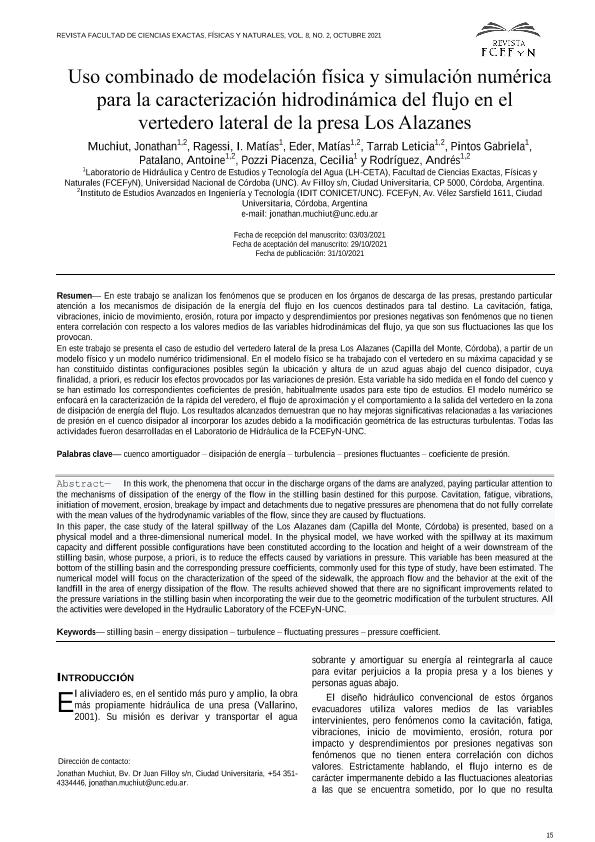Artículo
En este trabajo se analizan los fenómenos que se producen en los órganos de descarga de las presas, prestando particular atención a los mecanismos de disipación de la energía del flujo en los cuencos destinados para tal destino. La cavitación, fatiga, vibraciones, inicio de movimiento, erosión, rotura por impacto y desprendimientos por presiones negativas son fenómenos que no tienen entera correlación con respecto a los valores medios de las variables hidrodinámicas del flujo, ya que son sus fluctuaciones las que los provocan. En este trabajo se presenta el caso de estudio del vertedero lateral de la presa Los Alazanes(Capilla del Monte, Córdoba), a partir de un modelo físico y un modelo numérico tridimensional.En el modelo físicoseha trabajado con el vertedero en su máxima capacidad y se han constituido distintas configuraciones posibles según la ubicación y altura de un azud aguas abajo del cuenco disipador, cuya finalidad, a priori, es reducir los efectos provocados por las variaciones de presión. Esta variable ha sido medida en el fondo del cuencoyse han estimado los correspondientes coeficientes de presión, habitualmente usados para este tipo deestudios. El modelo numérico se enfocará en la caracterización de la rápida del veredero, el flujo de aproximación y el comportamiento a la salida del vertedero en la zona de disipación de energía del flujo. Los resultados alcanzados demuestran que no hay mejoras significativas relacionadas a las variaciones de presión en el cuenco disipador al incorporar los azudes debido a la modificación geométrica de las estructuras turbulentas. Todas las actividades fueron desarrolladas en el Laboratorio de Hidráulica de la FCEFyN-UNC. In this work, the phenomena that occur in the discharge organs of the dams are analyzed, paying particular attention to the mechanisms of dissipation of the energy of the flow in the stilling basin destined for this purpose. Cavitation, fatigue, vibrations, initiation of movement, erosion, breakage by impact and detachments due to negative pressures are phenomena that do not fully correlate with the mean values of the hydrodynamic variables of the flow, since they are caused by fluctuations. In this paper, the case study of the lateral spillway of the Los Alazanes dam (Capilla del Monte, Córdoba) is presented, based on a physical model and a three-dimensional numerical model. In the physical model, we have worked with the spillway at its maximum capacity and different possible configurations have been constituted according to the location and height of a weir downstream of the stilling basin, whose purpose, a priori, is to reduce the effects caused by variations in pressure. This variable has been measured at the bottom of the stilling basin and the corresponding pressure coefficients, commonly used for this type of study, have been estimated. The numerical model will focus on the characterization of the speed of the sidewalk, the approach flow and the behavior at the exit of the landfill in the area of energy dissipation of the flow. The results achieved showed that there are no significant improvements related to the pressure variations in the stilling basin when incorporating the weir due to the geometric modification of the turbulent structures. All the activities were developed in the Hydraulic Laboratory of the FCEFyN-UNC.
Uso combinado de modelación física y simulación numérica para la caracterización hidrodinámica del flujo en el vertedero lateral de la presa Los Alazanes
Muchiut, Jonathan ; Raggesi, Matías; Eder, Matías
; Raggesi, Matías; Eder, Matías ; Tarrab, Leticia
; Tarrab, Leticia ; Pintos, Gabriela; Patalano, Antoine
; Pintos, Gabriela; Patalano, Antoine ; Pozzi Piacenza, Cecilia Elena; Rodriguez, Andres
; Pozzi Piacenza, Cecilia Elena; Rodriguez, Andres
 ; Raggesi, Matías; Eder, Matías
; Raggesi, Matías; Eder, Matías ; Tarrab, Leticia
; Tarrab, Leticia ; Pintos, Gabriela; Patalano, Antoine
; Pintos, Gabriela; Patalano, Antoine ; Pozzi Piacenza, Cecilia Elena; Rodriguez, Andres
; Pozzi Piacenza, Cecilia Elena; Rodriguez, Andres
Fecha de publicación:
10/2021
Editorial:
Universidad Nacional de Córdoba. Facultad de Ciencias Exactas, Físicas y Naturales
Revista:
Revista de la Facultad de Ciencias Exactas, Físicas y Naturales
e-ISSN:
2362-2539
Idioma:
Español
Tipo de recurso:
Artículo publicado
Clasificación temática:
Resumen
Palabras clave:
CUENCO DISIPADOR
,
DISCIPACION D ENERGIA
,
TURBULENCIA
,
PRESIONES FLUCTUANTES
Archivos asociados
Licencia
Identificadores
Colecciones
Articulos(IDIT)
Articulos de INSTITUTO DE ESTUDIOS AVANZADOS EN INGENIERIA Y TECNOLOGIA
Articulos de INSTITUTO DE ESTUDIOS AVANZADOS EN INGENIERIA Y TECNOLOGIA
Citación
Muchiut, Jonathan; Raggesi, Matías; Eder, Matías; Tarrab, Leticia; Pintos, Gabriela; et al.; Uso combinado de modelación física y simulación numérica para la caracterización hidrodinámica del flujo en el vertedero lateral de la presa Los Alazanes; Universidad Nacional de Córdoba. Facultad de Ciencias Exactas, Físicas y Naturales; Revista de la Facultad de Ciencias Exactas, Físicas y Naturales; 8; 2; 10-2021; 15-24
Compartir



